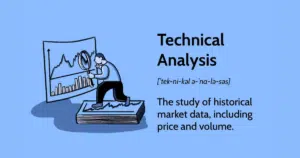Understanding Technical Analysis/Trend Analysis (TA)
Technical analysis, also known as trend analysis, is a method of studying market behavior using price charts to predict future price movements.
It is based on the belief that all factors influencing market prices, including fundamental knowledge, political events, natural disasters, and psychological factors, are quickly reflected in market activity.
In other words, the impact of these external events will immediately manifest in either upward or downward price movements.

Technical Analysis Explanation | Source: Investopedia
Is Technical Analysis a Good Long-Term Investment Strategy?
No, technical analysis is not typically used as a long-term investment strategy.
Technical analysts are known for their active trading approach, holding positions for short periods to capitalize on upward and downward market swings.
Based on data predictions, technical analysts may take a long or short position on a coin.
If a coin does not perform as expected, analysts quickly decide to exit their positions and may use stop-loss orders to limit losses.
While value investors exercise patience and wait for the market to correct undervalued coins, technical analysts require agility in trading, swiftly entering and exiting positions.
Support and Resistance
Support and resistance are fundamental concepts in technical analysis.
These levels are where analysts anticipate a coin to start rising after a decline (support) or falling after a gain (resistance).
These critical levels guide trading decisions, suggesting how a coin will likely rebound.
Analysts may take a long position if they believe a support level has been reached or a short position if they believe a resistance level has been reached.
Basic Assumptions in Technical Analysis
Technical analysis theory is based on three fundamental assumptions:
- Everything is discounted in the market: Analysts believe that the price of a coin already incorporates the influence of all factors, from fundamentals to broader market psychology.
- Price moves in trends: Technical analysts contend that prices exhibit patterns even in non-uniform market movements, regardless of the observed time frame.
- History repeats itself: Technical experts believe history tends to repeat due to predictable market psychology, which consistently affects pricing.
Fundamental Analysis vs Technical Analysis
Fundamental and technical analyses are used to analyze and forecast future asset price patterns.
However, they differ in the type of data they analyze.
Fundamental analysis assesses the intrinsic value of an asset by evaluating its industry, business, and overall environment.
Technical analysis, on the other hand, focuses solely on price and volume data.
Technical analysts believe that all known factors examined in the fundamental analysis are already reflected in the price and do not require further examination.
Additionally, technical analysts do not attempt to calculate long-term value.
Instead, they utilize charts to identify patterns and trends that indicate future price movements in the near term.
Limitations of Technical Analysis
Critics of technical analysis argue that the assumption of history repeating itself is not always accurate, as market dynamics can change.
Another criticism is that technical analysis is situational and sometimes becomes a self-fulfilling prophecy.
Additionally, technical analysis is limited to studying market patterns and does not delve deep into understanding an instrument’s or sector’s inner workings.
Technical analysis is most useful and informative when the market has already begun moving in a specific direction rather than attempting to predict the movement, which requires studying fundamental background information.